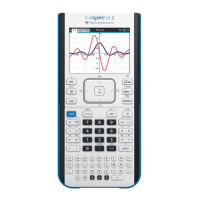Using Lists & Spreadsheet 187
• To refer to a variable whose name could conflict with the name of a
cell (such as A1), precede the variable name with an apostrophe
(‘A1). Or, you can avoid choosing names that are similar in format to
cell and column names (such as A and A1).
• To refer to a column (such as A) without conflicting with a single-
letter variable name A, follow the column letter with a pair of
brackets (A[]).
Note: In certain examples, Lists & Spreadsheet may not display the
Conflict Detected dialog box to notify you of a possible variable-name
conflict. Also, the dialog box may appear even when you have used the
apostrophe or brackets to prevent a conflict. Name variables using two or
more characters to prevent this conflict.
Working with rows and columns of data
Selecting a row or column
f Move to the top of the column, and then press £. (You can also click
the column reference letter.)
– or –
Move to the leftmost cell of the row, and then press ¡. (You can also
click the row reference number.)
Resizing a row or column
1. Point to the boundary of the row or column that you want to resize.
The pointer changes to a double-headed arrow.
To refer to:
Use this
syntax: Remarks
The shared variable A1. ‘A1 The apostrophe avoids a possible
conflict with spreadsheet cell A1.
The spreadsheet cell at
column A, row 1.
A[1] This syntax always refers to a
spreadsheet cell, avoiding a
possible conflict with variable A1.
Column A of the
current spreadsheet.
A[] Brackets avoid a possible conflict
with variable A.
The shared variable
myvar.
myvar No special syntax needed, because
this name does not conflict with a
cell or column reference.

